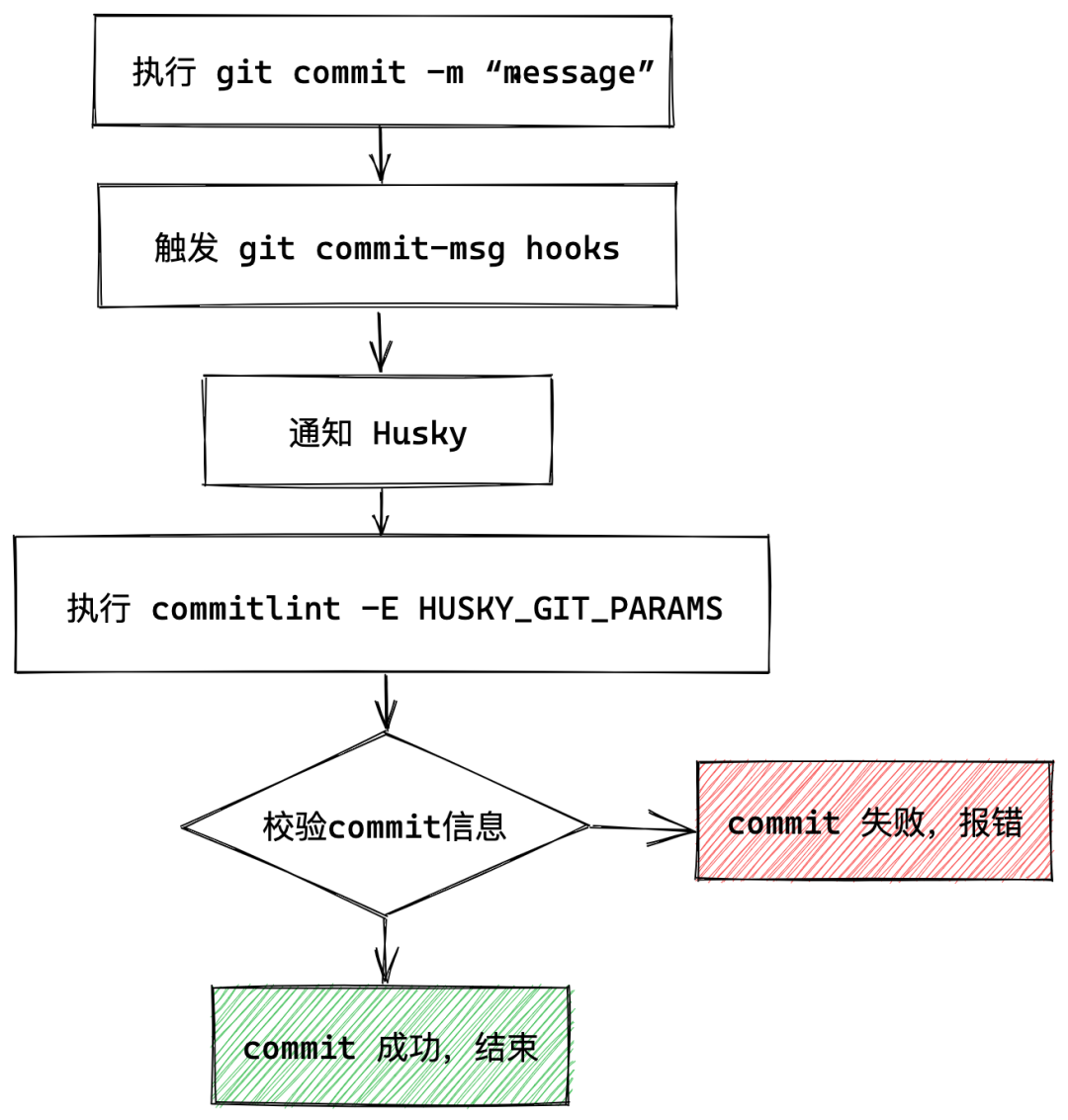如何配置 Git 提交代码检查?
今天来看看如何使用 commitlint + Husky 在 git commit 时规范提交信息!
1 . 基本概述
在多人协同的团队中,规范化的提交信息更易读,便于查找。每个人的 git commit 的信息不一样,没有一个机制就很难保证规范化。而 commitlint 就可以帮助我们解决这个问题。Commitlint 是一个自动化工具,它可以用来检查提交约定,如果提交不符合规范,则会拒绝该提交。当然,这些规则是可以配置的。
使用 commitlint 的优点:
- 自动变更日志:由于遵循标准约定的提交,可以使用
standard-version等工具自动生成变更日志; - 更好的理解提交:具有特定类型和范围的提交将帮助我们了解提交更改了哪些代码;
- 遵守特定约定:多人协作的的大项目中,commitlint 可以阻止不规范的提交,以便提交遵守定义的约定。
Git 允许开发人员在触发特定事件时执行一些操作,它被称为git hook。我们可以在git工作流程的很多阶段执行操作,例如:
pre-commitpre-pushpre-rebasepost-update
然而,这需要在本地的 .git 文件中配置的,因此在默认情况下,每个开发人员都需要安装需要的 hook,这样才能执行特定的检查。幸运的是,Husky 可以帮助我们解决这个问题,husky 可以让我们在项目中方便添加 git hooks。Husky 不仅可以用于强制执行提交约定,还可以在提交时运行静态代码分析、测试、自动代码格式化等。
因此我们可以使用Husky和commitlint来检查提交信息是否符合提交规范。
2 . 安装配置
由于 Commitlint 使用了 Husky,我们需要先安装它。Husky 是作为开发依赖项提供的,因此它仅在本地使用,不会与生产代码捆绑在一起。在终端中执行以下命令来安装Husky:
// 使用npm安装
npm install --save-dev husky
// 使用yarn安装
yarn add husky --dev现在我们需要定义一个 Hook 来检查提交信息,这个 hook 叫做 commit-msg,需要在 package.json 中定义:
"husky": {
"hooks": {
"commit-msg": "commitlint -E HUSKY_GIT_PARAMS"
}
}或者,我们也可以项目的根目录定义一个.huskyrc配置文件,在这个配置文件中单独定义 Husky 配置:
{
"hooks": {
"commit-msg": "commitlint -E HUSKY_GIT_PARAMS"
}
}这段代码就告诉git hooks,当我们执行 git commit -m 'message' 时将触发commit-msg 事件钩子并通知 husky,从而执行 commitlint -e $GIT_PARAMS命令。该命令会读取commitlint.config.js 配置的规则并对提交的信息进行校验,若校验不通过,就会在终端中输出错误,commit 被终止。
有了 Husky,接下来就需要安装 Commitlint CLI,它将由 Husky hook 执行以验证提交消息:
// 使用npm安装
npm install --save-dev @commitlint/cli
// 使用yarn安装
yarn add @commitlint/cli --devCommitlint 只是用于检查提交消息是否符合规范的工具。所以,我们还需要一个提交规范。这个配置是完全可以自定义的,当然,Commitlint 提供了当前支持的配置之外的一些配置:
- @commitlint/config-conventional
- @commitlint/config-lerna-scopes
- @commitlint/config-patternplate
- @commitlint/config-angular
- @commitlint/config-angular-type-enum
Commitlint 推荐使用 config-conventional 配置去规范 commit,安装命令如下:
// 使用npm安装
npm install --save-dev @commitlint/config-conventional
// 使用yarn安装
yarn add @commitlint/config-conventional --dev最后一步,我们需要创建一个 Commitlint 配置文件,在文件中可以定义需要使用的配置,也就是上面刚安装的配置规范。只需要在项目的根目录创建一个名为commitlint.config.js的规范:
module.exports = {
extends: ['@commitlint/config-conventional'],
};到这里就完成了 Husky 和 Commitlint 的安装和配置。其执行流程如下:
3 . 提交规范
Commitlint 推荐使用 config-conventional 配置,它的提交格式如下:
git commit -m <type>[optional scope]: <description>
这里面有三个参数:
type:必须,表示提交的改动类型;optional scope:可选,表示提交的修改范围,需要使用括号包裹;description:必须,表示提交的内容描述。
常见的 type 类型如下:
- build: 影响构建组件的更改,如构建工具、依赖项、项目版本等;
- chore: 比如构建流程、辅助工具等的更改。
- ci: 持续集成的更改;
- docs: 影响文档的更改。
- feat: 引入新功能的更改。
- fix: 修补错误的更改。
- perf: 优化相关,比如提升性能、体验。
- refactor: 代码重构的更改。
- revert: 还原先前提交的更改。
- style: 代码格式的更改(空格、格式、缺少分号等)。
- test: 添加缺失测试或纠正现有测试的更改。
例如:
git commit -m 'feat: 增加 xxx 功能'
git commit -m 'feat(xx模块): 增加 yyy 功能'
git commit -m 'fix: 修复 xxx 问题'下面是一个git提交信息的例子:

config-conventional 配置是如何定义的:
module.exports = {
parserPreset: 'conventional-changelog-conventionalcommits',
rules: {
'body-leading-blank': [1, 'always'],
'body-max-line-length': [2, 'always', 100],
'footer-leading-blank': [1, 'always'],
'footer-max-line-length': [2, 'always', 100],
'header-max-length': [2, 'always', 100],
'scope-case': [2, 'always', 'lower-case'],
'subject-case': [
2,
'never',
['sentence-case', 'start-case', 'pascal-case', 'upper-case'],
],
'subject-empty': [2, 'never'],
'subject-full-stop': [2, 'never', '.'],
'type-case': [2, 'always', 'lower-case'],
'type-empty': [2, 'never'],
'type-enum': [
2,
'always',
[
'build',
'chore',
'ci',
'docs',
'feat',
'fix',
'perf',
'refactor',
'revert',
'style',
'test',
],
],
},
};这里面包含了很多配置项,这些配置项由配置名和配置数组组成,数组的第一个元素是level,可选值0、1、2,0为disable,1为warning,2为error,第二个元素为是否应用与否,可选值always、never,第三个元素是配置规则。
上面是config-conventional的默认规则,我们可以在 commitlint.config.js 配置文件中覆盖这些规则:
module.exports = {
extends: ['@commitlint/config-conventional'],
rules: {
'scope-case': [0, 'never'],
'header-max-length': [0, 'always', 120]
}
};